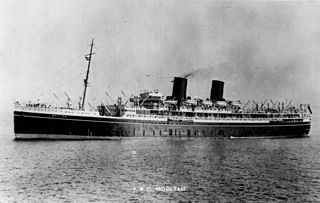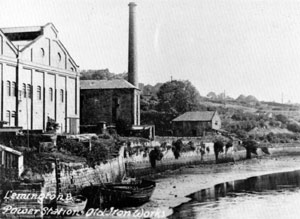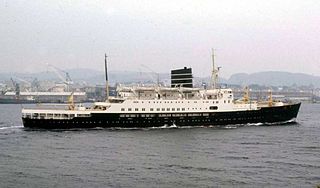
Newcastle upon Tyne, commonly known as Newcastle, is a city in Tyne and Wear, North East England, 103 miles (166 km) south of Edinburgh and 277 miles (446 km) north of London on the northern bank of the River Tyne, 8.5 mi (13.7 km) from the North Sea. Newcastle is the most populous city in the North East, and forms the core of the Tyneside conurbation, the eighth most populous urban area in the United Kingdom. Newcastle is a member of the UK Core Cities Group and is a member of the Eurocities network of European cities.

Turbinia was the first steam turbine-powered steamship. Built as an experimental vessel in 1894, and easily the fastest ship in the world at that time, Turbinia was demonstrated dramatically at the Spithead Navy Review in 1897 and set the standard for the next generation of steamships, the majority of which would be turbine powered. The vessel is currently located at the Discovery Museum in Newcastle upon Tyne, North East England, while her original powerplant is located at the Science Museum in London.

The Pacific Mail Steamship Company was founded April 18, 1848, as a joint stock company under the laws of the State of New York by a group of New York City merchants, William H. Aspinwall, Edwin Bartlett, Henry Chauncey, Mr. Alsop, G.G. Howland and S.S. Howland. These merchants had acquired the right to transport mail under contract from the United States Government from the Isthmus of Panama to California awarded in 1847 to one Arnold Harris.

RMS Mooltan was an ocean liner and Royal Mail Ship of the Peninsular and Oriental Steam Navigation Company (P&O). She was ordered in 1918 and completed in 1923. She served in the Second World War first as the armed merchant cruiser HMS Mooltan (F75) and then as a troop ship. She was retired from P&O service in 1953 and scrapped in 1954.

Tyne and Wear Archives is the record office for the metropolitan county of Tyne and Wear, in North East England. Tyne and Wear Archives preserve documents relating to the area from the 12th to the 21st century. It is based in the former headquarters of the Co-operative Wholesale Society, which it shares with Discovery Museum in Newcastle upon Tyne.
SS Cheviot was an iron screw steamer built by Charles Mitchell and Co., of Low Walker, Newcastle upon Tyne, England in 1870. She was owned by Wm. Howard Smith & Sons, Melbourne, Australia, for the transportation of coal and passengers. In 1887, she was wrecked in rough seas near Point Nepean in Victoria, Australia, with the loss of 35 lives, after the propeller was disabled. The beach nearby was subsequently named Cheviot Beach.

Lemington Power Station is a small, now defunct coal-fired power station, located in North East England. It is situated on the Lemington Gut, a backwater of the River Tyne, at Lemington, 3.5 mi (5.6 km) west of Newcastle upon Tyne. The station's main building still stands today and is a rare example of an early power station, dating from before the nationalisation of the United Kingdom's electrical supply industry.

SS Fiscus was a UK cargo steamship that was built in 1928, served in the Second World War and was sunk by a U-boat in 1940.
SS Empire Clansman was a 2,065 ton collier which was built in 1942 for the Ministry of War Transport (MoWT). She saw service mainly in British coastal waters during the Second World War, before running aground and being badly damaged in 1945. She was subsequently salvaged and returned to service for several companies after the war, under the names Sheaf Field, Corfield and then Spyros Amrenakis, before being wrecked for a second and final time in 1965.

The Bergen Steamship Company (BDS), was founded in 1851 by Michael Krohn to operate a shipping service between the Norwegian ports of Bergen, Stavanger, and Kristiansand and the German port of Hamburg with the paddle steamer Bergen. The company funnel was black with three widely spaced narrow white bands.
The Tyne Tees Steam Shipping Company provided shipping services in the United Kingdom from 1904 to 1943.
SS Glentworth was a shelter deck cargo steamship built in 1920 by Hawthorn Leslie & Co. in Newcastle-upon-Tyne, England for R.S. Dalgliesh and Dalgliesh Steam Shipping Co. Ltd., also of Newcastle-upon-Tyne. After the Great Depression affected UK merchant shipping in the first years of the 1930s, Dalgliesh sold Glentworth to a company controlled by Counties Ship Management who renamed her SS Box Hill.

SS Wandle was a British coastal collier owned and operated by the proprietors of Wandsworth gas works in south-west London. She was a flatiron, meaning that she had a low-profile superstructure, hinged funnel, hinged or telescopic mast and folding wheelhouse to enable her to pass under low bridges on the tidal River Thames upriver from the Pool of London. She was in service from 1932 to 1959 and survived a number of enemy attacks in the Second World War.

The Clan Mackinnon was a 7,373 GRT cargo ship that was built in 1945 as Empire Dunnet by William Gray & Co Ltd, West Hartlepool, Co Durham United Kingdom for the Ministry of War Transport (MoWT). She was sold into merchant service in 1946 and renamed Clan Mackinnon. In 1961 she was sold to a Hong Kong company and renamed Ardross. A sale to a Panamanian owner in 1963 saw her renamed Labuan Bay. She served until 1967, when she was wrecked off Borneo.

SS Conister (I) No. 145470 – the first vessel in the Company's history to bear the name – was a coastal cargo vessel which was purchased by the Isle of Man Steam Packet Company from Cheviot Coasters Ltd, in 1932.
There have been several vessels named Nubia or SS Nubia:
SS Gasfire was a British steam collier of the Gas Light and Coke Company (GLCC). She was built in Sunderland in 1936, survived severe damage from being torpedoed in 1940 and was sunk by a mine in the North Sea in 1941.
SS Alt was a freight vessel built for the Lancashire and Yorkshire Railway in 1911.
SS Laura was a passenger vessel built for the London and South Western Railway in 1885.
PS Mayflower was a passenger vessel built for the Solent Steam Packet Company in 1866.














